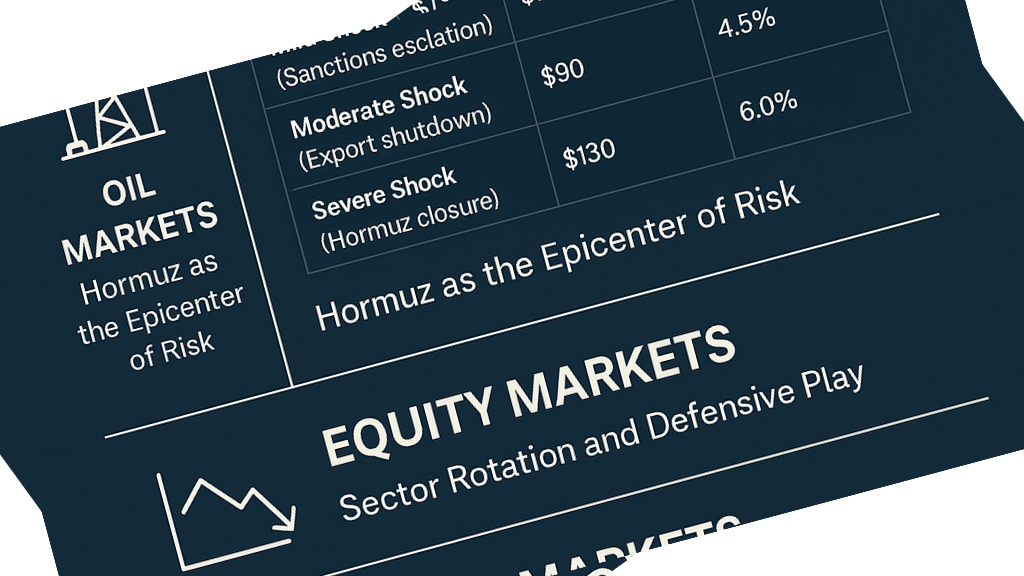
As geopolitical tensions rise in the Middle East—particularly between Iran and Israel—global financial markets are confronting renewed volatility. The recent U.S. military strikes have intensified investor anxiety across commodities, equities, and bond markets. While headlines highlight the conflict, the deeper concern lies in oil supply security and macroeconomic stability.
This article outlines actionable strategies and scenario analysis to help investors make informed decisions during this period of uncertainty.
Oil Markets: Hormuz as the Epicenter of Risk
The Strait of Hormuz, a strategic chokepoint through which nearly 20% of the world’s oil supply passes, has become a critical risk node. The potential for disruption here is already being priced into Brent crude futures.

Energy traders currently assign a 25% probability to a severe disruption. While the U.S. has improved energy independence, global interconnectivity ensures domestic prices remain sensitive to external shocks.
Equity Markets: Sector Rotation and Defensive Play
Initial market reactions reflect heightened volatility:
- Energy stocks surged 7% after the strikes but quickly corrected.
- The S&P 500 saw a modest 0.5% dip before stabilizing.
- Defensive sectors—consumer staples and utilities—outperformed cyclicals by 3.2%.
The VIX index suggests market nervousness, with futures pricing in 30% more volatility compared to pre-conflict levels.
Bond Markets: Inflation Risks Reshape Rate Expectations
Bond markets are rapidly repricing interest rate expectations:
- U.S. 10-year yields rose 15 basis points to 4.40%.
- German bunds climbed 5 basis points to 2.56%.
The expectation for aggressive Fed rate cuts has diminished. Futures now reflect only 25bps of potential cuts in 2025, compared to 75bps before the conflict.Strategic Guidance for Investors
What to Do Now
- Diversify Energy Exposure: Use Brent call options at $80–$85 strikes to hedge supply disruption risk.
- Increase Safe-Haven Allocations: Allocate 10–15% of portfolios to gold and U.S. Treasuries.
- Review Energy Sector Holdings: Prioritize integrated oil majors with downstream operations and renewable energy strategies.
- Sector Opportunities:
What to Avoid
- Emerging Markets exposed to Middle Eastern oil routes
- High-Duration Bonds vulnerable to inflation-driven sell-offs
- Cyclical Sectors such as airlines and discretionary spending
- Leveraged Trades—reduce margin risk during volatile periods
Scenario Planning & Portfolio Stress Testing
Model multiple escalation outcomes to assess portfolio resilience:

Tools to Use:
- Protective puts on SPY, QQQ
- Currency hedging for USD strength
- Sector correlation analysis to reduce concentration risk
Key Data Sources to Monitor
- EIA Petroleum Status Reports: U.S. refinery output & inventory data
- OPEC Monthly Reports: Production forecasts and spare capacity
- Strait of Hormuz Traffic: Track tanker movement via MarineTraffic
- Break-even Inflation Rates: 5Y/10Y TIPS spreads
- Fed Funds Futures: Rate expectations
- VIX & Oil Volatility Indexes: Market stress indicators
- IAEA & U.S. State Department updates on nuclear and regional risks
Markets currently price a 65% probability of de-escalation, yet the risk of underappreciated tail events remains. As Allianz GI aptly puts it, “OPEC’s spare capacity offers a buffer—but not an indefinite one.” Prudent investors must prepare for both probable and worst-case outcomes.
Stay vigilant, stay diversified, and stay informed.
